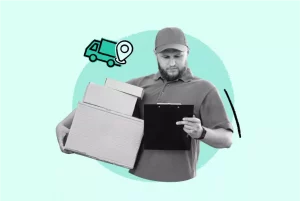
Last-Mile Delivery Tracking: What You Should Be Focusing On
Order tracking is a must, from the moment the package leaves the warehouse to the very last mile. But what should you be focusing on?
Shipping, Tracking & Notifications
Boost customer experience and reduce support tickets
Realtime order and shipment tracking
Proactive order and shipping notifications
AI-Enhanced Discounted Labels
Predictive pre-purchase estimated delivery dates
Self-Serivce branded order tracking
Effortless experience delivered
Identify and Resolve Order Issues
Realtime order and shipment tracking
Make returns profitable and delight customers
Flexibility to define any return destinations & conditions
Simplify returns for your customers and team
Incentivize exchanges over returns
Returns management made easy for your team
Returns management made easy for your team
Easy claims and smart upsells
Understand why your customers are returning
In-Store & Curbside Pickup
Unify the online and the in-store experience
Hassle-free pickup experience for customers
In-Store dashboard to keep operations streamlined
In-Store and Online orders unified
Drive foot-traffic to your stores
Shipping, Tracking & Notifications
Boost customer experience and reduce support tickets
Realtime order and shipment tracking
Proactive order and shipping notifications
AI-Enhanced Discounted Labels
Predictive pre-purchase estimated delivery dates
Self-Serivce branded order tracking
Effortless experience delivered
Identify and Resolve Order Issues
Realtime order and shipment tracking
Make returns profitable and delight customers
Flexibility to define any return destinations & conditions
Simplify returns for your customers and team
Incentivize exchanges over returns
Returns management made easy for your team
Returns management made easy for your team
Understand why your customers are returning
In-Store & Curbside Pickup
Unify the online and the in-store experience
Hassle-free pickup experience for customers
In-Store Dashboard to keep operations streamlined
In-Store and Online orders unified
Drive foot-traffic to your stores
Boost customer experience and reduce support tickets
Realtime order and shipment tracking
Proactive order and shipping notifications
AI-Enhanced Discounted Labels
Predictive pre-purchase estimated delivery dates
Self-Serivce branded order tracking
Effortless experience delivered
Make returns profitable and delight customers
Flexibility to define any return destinations & conditions
Simplify returns for your customers and team
Incentivize exchanges over returns
Returns management made easy for your team
Equip your team for precise return checks.
Easy claims and smart upsells
Understand why your customers are returning
Unify the online and the in-store experience
Hassle-free pickup experience for customers
In-Store Dashboard to keep operations streamlined
In-Store and Online orders unified
Drive foot-traffic to your stores
Find the answer to all your questions
Take a step by step trip through our functionality to see how we can improve your ecommerce processes.
Explore the most comon questions about WeSupply
Calculate the ROI that WeSupply can bring you
Read actionable articles on how to optimize your post-purchase experience and decrease support tickets
Get inspired by stories of how our customers implemented an effortless post-purchase experience
Wondering if WeSupply is a good fit for you? Read through our use cases to see how we can help you increase conversion & improve CX!
A Deep Dive into Top Companies' Order Tracking & Returns Strategy
Find the answer to all your questions
Explore the most comon questions about WeSupply
Calculate the ROI that WeSupply can bring you
Request a no strings attached review of your current shopping experience and missed conversion opportunities
Take a step by step trip through our functionality to see how we can improve your ecommerce processes.
Read actionable articles on how to optimize your post-purchase experience and decrease support tickets
Get inspired by stories of how our customers implemented an effortless post-purchase experience
A Deep Dive into Top Companies' Order Tracking & Returns Strategy
Wondering if WeSupply is a good fit for you? Read through our use cases to see how we can help you increase conversion & improve CX!
It can be faster to send a split shipment, meaning some packages can reach your customers sooner. But what to consider beforehand?

Whether a product is too heavy to fit in with the rest in one single package or the customer’s changed their mind and added something else to their order, split shipments make up a significant part of logistics.
You’ve also probably been there before, as a consumer as well. Have you ever ordered something online and it’s shipped in multiple boxes?
Truth is that trying to keep track of the exact location of each package and its estimated time of arrival is not exactly a walk in the park. For customers, it’s easy to miss a delivery because they didn’t know the package was coming or that there were multiple packages they should’ve been expecting.
Order tracking tools for split orders can help make this process a lot easier. You can easily see where each package is and when it is expected to arrive, and customers can get your items as quickly as possible without running into any obstacles.
Simply put, a split shipment happens when one order contains multiple items that are shipped in more than one package.
For example, when dealing with a backorder situation, you might ship a part of the order first and then the other. Shipping packages separately might help improve end-to-end processing time and maintain a competitive edge or deliver available products first and then those that were out-of-order.
However, if your current tracking software does not come with accurate, real-time updates, delivery notifications, delivery exception alerts, etc., it can lead to an increase in customer support tickets.
This can especially happen when customers receive just a part of the products they ordered without knowing the order has been split into a couple of different packages, having to contact the customer support center. Besides, no one wants packages to get lost, deliveries to be failed, and customers to complain.
To get rid of the customer frustration, increase customer LTV (lifetime value), and relieve some of the pressure from your customer care team, it’s necessary to use tools like WeSupply and track all orders under the same roof while monitoring split shipments with ease in one single dashboard.
Your customers will always know where their packages are and everyone is satisfied. Happy ending!
Just like a split order, a partial shipment refers to the fulfillment of one order in two or more packages delivered separately. On the other end, customers receive multiple packages separately instead of one under the same order.
In fact, partial shipment is just another way to say split shipment.
Below you can see how the average partial shipping process unfolds for most online retailers for a better understanding:
On the other hand, invoice split refers to the financial aspect of the order, instead of the logistics and order fulfillment per se.
An invoice split refers to splitting one invoice into two or more other invoices. This enables retailers to provide their customers with flexible payments.
One common example would be paying in installments or “buy now, pay later” options that are increasingly becoming more popular across a variety of industries, from apparel items to electronics.
To sum it up, splitting an invoice allows the customer to spread out multiple payments for a single order across multiple invoices, charging a certain percentage of the sum total with each installment.
You might want to have multiple shipments when you’re delivering heavy equipment, machinery parts, fragile products, big pieces of furniture, and so on. In fact, oftentimes you won’t even have a choice since carriers have their own rules and limitations, for instance, a certain maximum weight or height allowed.
Another reason for partial shipments is the lack of availability of a product that has not been foreseen. In the case of back-ordered items, you might want to send a part of the order faster and then ship out the rest.
Moreover, you might be sending items from different warehouses or distribution centers, therefore, packing and delivering packages separately. This can also happen when the same merchant sells products through different vendors and manufacturers.
Before proceeding to ship an item, make sure you follow any guidelines imposed by your partner carriers regarding size and weight. To make it easier for you, here are some common examples:
It comes as no surprise that among the most common split shipment challenges we have:
Basically, you have to pay for transportation to the exact same location, but twice or more times per order. This can often come as an unnecessary expense that cannot be avoided.
If you don’t have enough visibility in your order management system, you will have a lot of backorder situations which can lead to an increased need to ship multiple products separately, paying additional transportation costs.
If you’re selling heavy items including car parts, lawnmowers, and the like, you might probably have no other choice but to ship items separately, but there are also highlights, as exemplified in the following section (Keep reading!).
Generation Z individuals (born between ~1995 to 2010) are concerned with environmental issues. In fact, a significant part of the surveyed Gen Z shoppers (62%) prefer to buy sustainable brands and they’re also more likely to spend 10% or more on sustainable products.
Shipping multiple packages separately might not settle well with some shoppers looking for sustainable and eco-friendly brands, which is also a driving factor for adopting a sustainable development strategy.
Below are the estimated greenhouse gas emissions of eCommerce in 2020 by source:
Increased waiting time for warehouses to process and ship orders might result in an increased volume of support tickets for your customer service reps.
Moreover, if you’re not enabling customers to track all shipments from the same order separately, they might try to get in touch with your team first. And, you know what they say, it’s too late to provide a premium post-purchase experience if your customers reach out first.
Moreover, some packages might be delayed due to unfavorable weather conditions, traffic congestion, and other causes outside your scope of control. You need to send out proactive status updates and delivery notifications to let customers know about any shipment delays in order to reduce the pressure from your customer support team.
Keep customers informed throughout the shipping and delivery process and have all orders under one single roof if you want to succeed and retain employees in this challenging business climate.
There’s one more truth about split shipments— they can also save you money and enable you to make better and more cost-effective decisions.
How is that possible? One good example is by avoiding paying dimensional weight on a larger package. There are cases in which you might not be able to fit all of the pieces in one box so it might be more cost-effective to ship two different packages and avoid unnecessary charges.
Besides, to avoid out-of-stock scenarios, try looking at purchasing trends to ensure the availability of your products. See which items you’re putting forward and make sure you avoid out-of-stock situations by planning ahead and tracking inventory efficiently. Enable effective cross-team communication and make sure all departments know what to keep an eye on.
Cut down on the final cost by simply improving your processes. For instance, make sure you offer order tracking and delivery notifications. Although you’re not shipping the entire order at once, your teams and customers should be able to monitor each shipment separately.
Check out the reviews below to see how important it is to provide your customers with a complete order tracking solution, delivery notifications, shipment exception updates, and information regarding their split order:
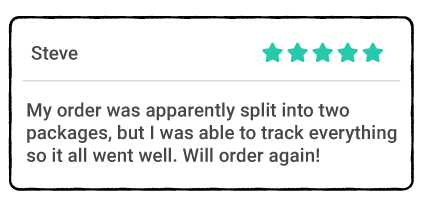
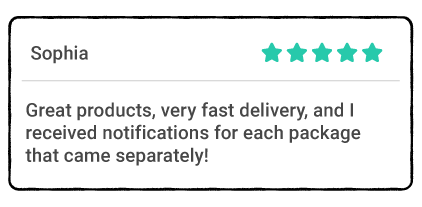
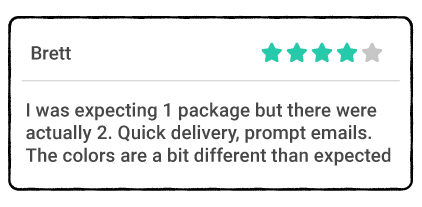
Splitting shipments is a necessary evil every now and then. This requires more packing materials, different locations to fulfill orders, and highly efficient inventory management.
In this regard, order tracking tools like WeSupply can help retailers monitor all orders under one roof to increase productivity and performance while driving customer satisfaction and meeting customer expectations.
By tracking split shipments, you can easily identify any errors or shipment delays and rectify them as soon as possible. Additionally, complete order details and shipping information can help improve future operations and create a fantastic customer experience.

Want more details about curbside pickup in retail?
Download this guide to learn everything you need to know about BOPAC!

Order tracking is a must, from the moment the package leaves the warehouse to the very last mile. But what should you be focusing on?
Advanced online order tracking is the solution you didn’t know you needed to take the post-purchase customer experience to the next level!
Why does your retail business need an omnichannel tracking solution for all orders? Keep reading this article to find out.

Times change and the behavior of porch pirates does too! Learn how to prevent package theft and protect your customers long-term.

How does curbside pickup work? It comes with both challenges and benefits, and we’re here to explain everything. Keep reading to learn more!
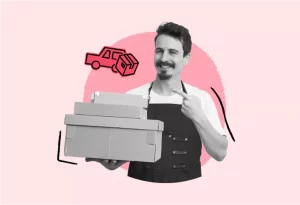
The question is no longer whether or not curbside delivery remains relevant, but why it will. Keep reading to see how you can use it to your advantage!

Explore the evolution and benefits of curbside pickup technology in retail. Learn how advanced systems, consumer trends, and best practices can streamline operations and enhance customer satisfaction. Get insights and strategies for successful curbside services in our comprehensive guide.
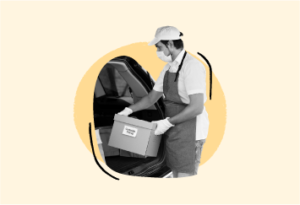
Curbside pickup offers a convenient and safe way for customers to collect online orders without entering the store. Learn about its historical roots, how it works, and why it’s becoming a popular choice for both retailers and shoppers.
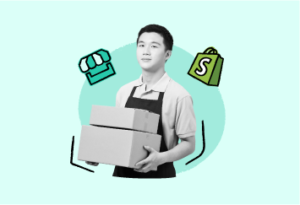
In terms of shipping, customers only want it two ways: quick and cheap. See how to grant their wishes and set up in-store pickup in Shopify!